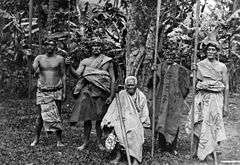Ariki
An ariki (New Zealand, Cook Islands), ꞌariki (Easter Island), aliki (Tokelau, Tuvalu), ali‘i (Samoa,[1] Hawai‘i), ari'i (Society Islands, Tahiti), aiki or hakaiki (Marquesas Islands), akariki (Gambier Islands) or ‘eiki (Tonga) is or was[2] a member of a hereditary chiefly or noble rank in Polynesia.[3][4]
New Zealand
Political leadership or governance in Māori society has traditionally come from two different groups of people – the ariki and the rangatira. The ariki are the "persons of the highest rank and seniority".[5] As the "high-ranking first-born children of first-born children", ariki inherit their positions from their forebears.[6] In particular, their "supreme rank [comes] from the conjunction of a number of senior descent lines from founding ancestors, and ultimately from the gods".[7] Although most ariki in the past have been male, women, like Te Atairangikaahu, have "brought their own qualities to bear on leadership ... [with] the expectations of them ... [being] the same as for men".[8][9]
Ariki do not operate in simple hierarchical organisations; despite what "government officers were inclined to believe", ariki have never been "the apex of a structured hierarchy of institutionalised tribal authority".[10] Many positions overlap with ariki holding multiple roles, including "head of an iwi, the rangatira of a hapu and the kaumatua of a whanau".[11] Similarly, in times past, "a tohunga may have also been the head of a whanau but quite often was also a rangatira and an ariki".[9][11]
The Māori King Movement is headed by the Māori King or Queen, who bears the title Te Arikinui, literally "The big (leading) Ariki".
Cook Islands

Each island in the Cook Islands was ruled by a number of ariki (high chiefs). Rarotonga had about five or six, and most of the other islands had about three. Each ariki ruled an ivi or ngati (tribe). Beneath each ariki in the social hierarchy were a number of mataiapo and rangatira (minor chiefs) of noble rank.[12]
A chief's control over his people was related to his mana (power), which came not only from his birth but also from his achievements and status, and could be gained or lost. An ariki who lost popularity with his people could also be seen as having a decline in mana, which could have led to his loss of control.[12]
Having a control of tapu (sacred matters) was a powerful weapon for the ariki. For supernatural reasons, certain activities were forbidden and since the ariki had control over what was or was not forbidden, this gave him considerable power. It was the people's strong belief in an ariki's mana and control over all things tapu that allowed them to take control of their people without the need for physical enforcement.[12]
The ariki, mataiapo and rangatira titles are passed down through the family to the present day. Some of the ancient ceremonies and traditions are still being practiced in the Cook Islands.[12]
The House of Ariki (Are Ariki) is a parliamentary body in the Cook Islands. It was established in 1967 shortly after self-government and is composed of the Cook Islands high chiefs. Scholars Ron Crocombe and Jon Tikivanotau Jonassen have argued that it was created to marginalize the ariki, giving them dignity but very limited power.[13]
See also
- Ali'i (Hawai'i)
- Paramount chief (Oceania)
References
- Sometimes pronounced aliki.
- The title has disappeared or has no official or institutional status in some islands (e.g. French Polynesia, Hawai‘i, Easter Island).
- Hale, Horatio (1846). United States Exploring Expedition During the Years 1838, 1839, 1840, 1841, 1842: Ethnography and Philology. 6. Philadelphia: Printed C. Sherman. p. 294.
- Fornander, Abraham; Stokes, John F. G. (1885). An Account of the Polynesian Race. 3. London: Trübner & Company. pp. 55–56.
- Ballara, A. (1998). Iwi: The dynamics of Māori tribal organisation from c.1769 to c.1945. Wellington, New Zealand: Victoria University Press. (p. 58).
- Ballara, A. (1998). Iwi: The dynamics of Māori tribal organisation from c.1769 to c.1945. Wellington, New Zealand: Victoria University Press. (p. 142).
- Ballara, A. (1998). Iwi: The dynamics of Māori tribal organisation from c.1769 to c.1945. Wellington, New Zealand: Victoria University Press. (p. 205).
- Mead, S. M. (1997). Landmarks, bridges and visions: Essays. Wellington, New Zealand: Victoria University Press. (p. 200).
- See also: Ballara, A. (1998). Iwi: The dynamics of Māori tribal organisation from c.1769 to c.1945. Wellington, New Zealand: Victoria University Press.
- Ballara, A. (1998). Iwi: The dynamics of Māori tribal organisation from c.1769 to c.1945. Wellington, New Zealand: Victoria University Press. (p. 264).
- Mead, S. M. (1997). Landmarks, bridges and visions: Essays. Wellington, New Zealand: Victoria University Press. (p. 197).
- Hunt, Errol (2003). Rarotonga & the Cook Islands. Lonely Planet. p. 10. ISBN 978-1-74059-083-9.
- Ron Crocombe and Jon Tikivanotau Jonassen. "Political culture, representation and the electoral system in the Cook Islands". Political Culture, Representation and Electoral Systems in the Pacific conference paper, Port Vila, Vanuatu, 10–12 July 2004
External links
- Arai-te-tonga, the ancient marae at Rarotonga. Journal of the Polynesian Society
- Tribal organisation - Social rank. Te Ara - the Encyclopedia of New Zealand
